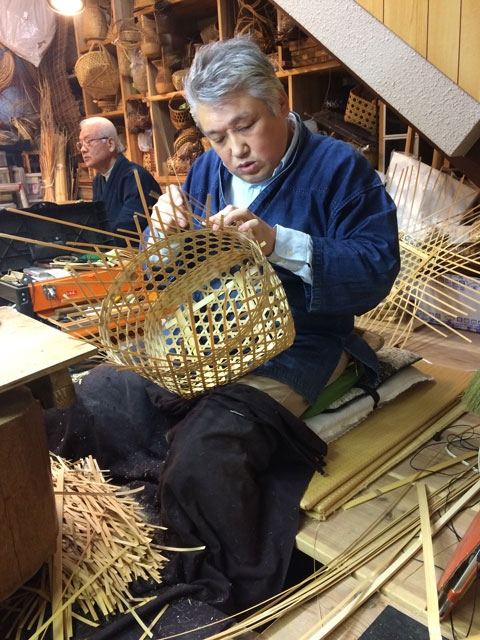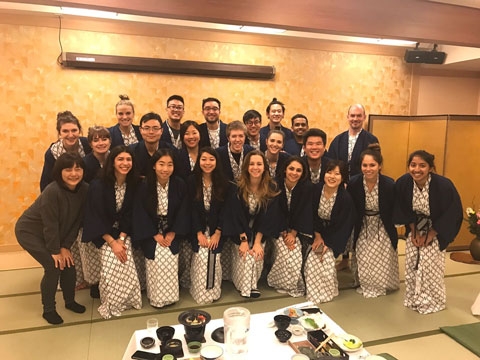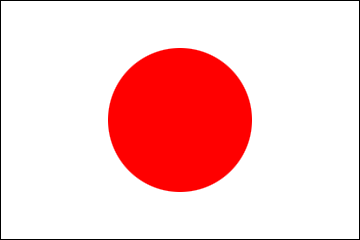One Bridge at a Time: An Undergraduate Perspective of the Kakehashi Program
2017/6/19

By Nitisha Baronia
Nitisha Baronia is student at UC Berkeley's Haas School of business and travelled to Japan as part of the 2017 Kakehashi Program.
With each car I counted as our flight landed in Tokyo, my imagination drove faster — I had never been to Japan before, and having attended multiple lecture sessions and written several papers on the country, I came to Japan with more than just the luggage in my overhead compartment. Along with it were a thousand questions about the country, its people, and its government. Japan and America are, in many ways, all too similar — both countries underwent rapid phases of industrialization, and both are host to some of the largest economies of the world. Yet in many ways, Japan is unique from the western world, and its historical, political, and geographic context make the country like no other. Nine days and three cities later, I learned not only about the intricate way of life of the Japanese people, but also about the unique craftsmanship and labour-focused industries that define the Japanese economy. Through the 2017 Kakehashi program, my 21 classmates from the University of California, Berkeley Haas School of Business learned about Japan’s political structure, its history, and even its anime. And while those nine days in Japan could fill an entire novel, the most important experience that I brought back home to Berkeley was a connection with the Japanese people that no souvenir or postcard could ever capture. Our class was truly captivated by the unique Japanese focus on artisanship and penchant for adaptability that we observed throughout the program. These qualities provided us with a cultural lens with which to better understand the nuances behind the Japanese economy, its politics, and its people.
As our Kakehashi group learned through multiple business tours, Japanese companies place a unique emphasis on quality and craftsmanship. From the Arima bamboo basket weaver who demonstrated artisan craftsmanship handed down over centuries of family practice to the Kanetetsu kamaboko factory manager who told our group about the care that his workers take to ensure the freshness of their fish cakes, every single Japanese business that we visited demonstrated the same attention to detail.
Nitisha Baronia is student at UC Berkeley's Haas School of business and travelled to Japan as part of the 2017 Kakehashi Program.
With each car I counted as our flight landed in Tokyo, my imagination drove faster — I had never been to Japan before, and having attended multiple lecture sessions and written several papers on the country, I came to Japan with more than just the luggage in my overhead compartment. Along with it were a thousand questions about the country, its people, and its government. Japan and America are, in many ways, all too similar — both countries underwent rapid phases of industrialization, and both are host to some of the largest economies of the world. Yet in many ways, Japan is unique from the western world, and its historical, political, and geographic context make the country like no other. Nine days and three cities later, I learned not only about the intricate way of life of the Japanese people, but also about the unique craftsmanship and labour-focused industries that define the Japanese economy. Through the 2017 Kakehashi program, my 21 classmates from the University of California, Berkeley Haas School of Business learned about Japan’s political structure, its history, and even its anime. And while those nine days in Japan could fill an entire novel, the most important experience that I brought back home to Berkeley was a connection with the Japanese people that no souvenir or postcard could ever capture. Our class was truly captivated by the unique Japanese focus on artisanship and penchant for adaptability that we observed throughout the program. These qualities provided us with a cultural lens with which to better understand the nuances behind the Japanese economy, its politics, and its people.
Monozukuri: The Japanese Art of Craftsmanship
As our Kakehashi group learned through multiple business tours, Japanese companies place a unique emphasis on quality and craftsmanship. From the Arima bamboo basket weaver who demonstrated artisan craftsmanship handed down over centuries of family practice to the Kanetetsu kamaboko factory manager who told our group about the care that his workers take to ensure the freshness of their fish cakes, every single Japanese business that we visited demonstrated the same attention to detail.

While monozukuri normally refers to craftsmanship in the creation of physical products, it was also ever present in Japanese food and services. On each day of the Kakehashi program, the group would be treated to a different cuisine, and each meal further demonstrated this attention to detail. Upon arriving in Tokyo, we were given steamed box dinners. Many of us had never seen or even thought of portable, steamed meals before. Yet this technology was used in Japan because of the special care that the Japanese place in ensuring that their food is always of the best quality, even if it must be consumed on the go. Subsequent meals were in beautiful local restaurants, each meal artistically prepared in the true style of Washoku. Even street food on bustling city corners was expertly crafted, with cooks taking care to understand the requests of both the tourists and locals they were serving. Whether at the airport, bullet train station, or a small gift shop, every employee constantly went above and beyond to provide excellent service.
One would expect that a nation whose people and business put so much thought and care into the minute details in their lives to be resistant to change. Yet in Japan, this is anything but the case. What truly makes Japan unique is not just monozukuri, but the flexible and adaptable nature of the Japanese people that accompanies it. This notion of Japanese flexibility, or “junansei,” was ubiquitous.
Perhaps the most prominent example of junansei is in the Japanese perspective on climate change. As an island nation, Japan is more vulnerable to the forces of climate change than inland countries, and unlike several countries, including the United States, the vast majority of Japanese politicians and businesses are aware of and willing to address the challenges that climate change poses. Japanese businesses are leading the global business community in terms of creating sustainable, green businesses. Take, for example, Daikin Air Conditioning. As part of the Kakehashi program, we visited a Daikin showroom and learned about the energy efficient, green air conditioning units that Daikin has developed. Daikin showroom staff informed our group that the company had released the patent for this green technology in order to ensure that other air conditioning companies can also produce energy efficient products. This willingness to reach out and collaborate allows for Japanese businesses to stay abreast of the latest technology and face demographic and geographic trends head-on. In a series of lectures at the Japanese Ministry of Foreign Affairs, Japanese government representatives reiterated the Japanese commitment to collaborating with other global leaders in order to address climate change, further demonstrating the Japanese commitment to understanding and addressing pressing global challenges.
Junansei: The Japanese Art of Adaptability
One would expect that a nation whose people and business put so much thought and care into the minute details in their lives to be resistant to change. Yet in Japan, this is anything but the case. What truly makes Japan unique is not just monozukuri, but the flexible and adaptable nature of the Japanese people that accompanies it. This notion of Japanese flexibility, or “junansei,” was ubiquitous.
Perhaps the most prominent example of junansei is in the Japanese perspective on climate change. As an island nation, Japan is more vulnerable to the forces of climate change than inland countries, and unlike several countries, including the United States, the vast majority of Japanese politicians and businesses are aware of and willing to address the challenges that climate change poses. Japanese businesses are leading the global business community in terms of creating sustainable, green businesses. Take, for example, Daikin Air Conditioning. As part of the Kakehashi program, we visited a Daikin showroom and learned about the energy efficient, green air conditioning units that Daikin has developed. Daikin showroom staff informed our group that the company had released the patent for this green technology in order to ensure that other air conditioning companies can also produce energy efficient products. This willingness to reach out and collaborate allows for Japanese businesses to stay abreast of the latest technology and face demographic and geographic trends head-on. In a series of lectures at the Japanese Ministry of Foreign Affairs, Japanese government representatives reiterated the Japanese commitment to collaborating with other global leaders in order to address climate change, further demonstrating the Japanese commitment to understanding and addressing pressing global challenges.

Even in the most trying of times, junansei persists. Like any other nation, Japan has faced its host of challenges, and several members of our group were particularly excited to visit Kobe after having read about the devastating 1995 Kobe earthquake. While memories of the great earthquake had certainly not faded, Kobe’s port, businesses, and people were as active and optimistic as ever. The city had undergone an incredible recovery, one that would later become a model for the even more rapid recovery of the Fukushima area after it, too, was the subject of a major earthquake and tsunami in 2011. Time and time again, our group heard from Japanese people who took pride in their ability to face challenges like natural disasters head-on and initiate immediate recovery plans. The results of this ability to adapt to and address challenges were evident throughout the trip, even in the places where we would least expect it.
Conclusion
One bridge at a time, the Kakehashi program is empowering students like myself to reach across the Pacific to understand and contribute to the relationship between Japan and the United States. Even after the program has concluded, classmates and I will certainly seek future opportunities to engage with Japan, and we have already begun to do so. In addition to sharing our experiences through social media, we have also begun several initiatives to continue building bridges between Japan and the United States. Recently, the Haas Business School Association invited Kyocera Document Solutions, a prominent Japanese company, and its president to Berkeley for a case competition. This case competition allowed members of the program to bring awareness about the diversity of Japanese businesses to other UC Berkeley students, and it was so heartening to see the number of students that turned out to the event, eager to learn about Japanese businesses.
Conclusion
One bridge at a time, the Kakehashi program is empowering students like myself to reach across the Pacific to understand and contribute to the relationship between Japan and the United States. Even after the program has concluded, classmates and I will certainly seek future opportunities to engage with Japan, and we have already begun to do so. In addition to sharing our experiences through social media, we have also begun several initiatives to continue building bridges between Japan and the United States. Recently, the Haas Business School Association invited Kyocera Document Solutions, a prominent Japanese company, and its president to Berkeley for a case competition. This case competition allowed members of the program to bring awareness about the diversity of Japanese businesses to other UC Berkeley students, and it was so heartening to see the number of students that turned out to the event, eager to learn about Japanese businesses.


Visiting Japan has truly been an incredible experience, and the Kakehashi program allowed for our group to learn not only about Japanese history and economics, but also the cultural factors that drive the success of Japanese businesses and the resilience of its people. We thank the Japanese government and the Kakehashi program for this once in a lifetime opportunity to immerse ourselves in the Japanese way of life. It has truly been an honor, and we will continue to take what we have learned and apply it to our daily lives, one bridge at a time. Arigato Gozaimasu.
